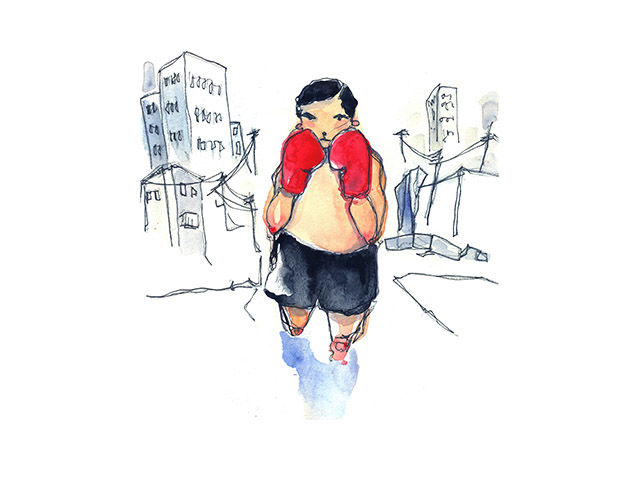Before I could go back to the Philippines in real life, I did so on paper, through my first novel.

May 10, 2017
A Filipino woman waits at the bus stop. She is my parents’ age. She studies me with a spark of recognition as I take a spot on the bench beside her. “Are you Filipino?” she asks. I answer “yes,” and following this confirmation, she asks the second question in Tagalog. “Have you been home?” The question reminds me I am part of something far away and from which I have been severed—a separation we share. “I was born there,” I reply, “but I haven’t been back since I was four.”
In this encounter and others like it, there’s no question as to where “home” is. Those who’ve left it share a certain longing. My sense of this “home” is infused with alienation because my memories of living in the Philippines are fuzzy, like photographs that have been submerged in water or faded over time. As a writer, I’m fortunate to have a tool to help me work through these feelings. Before I could go back to the Philippines in “real life,” I did so on paper through my first novel.
Research Is a Privilege
I recently read an article about the importance of firsthand research. You have to go to the places you write about—so that the streets will vibrate beneath you, the sounds and colors ring with clarity, and the experience of living as a character in the scene boost your writing to another level. True, but firsthand research is also a privilege. It takes airfare, time away from work and family, and access to room, board, and transportation while away.
In the case of going back to the Philippines, it also takes a certain pakikisama. This is the Filipino trait of working together, or going with the group. A trip home is a production that takes many others into consideration; it means visiting family member after family member, bringing them giant balikbayan boxes filled with American goods to distribute and share, and linking up with a personal guide, often a relative or childhood friend, to ground you and help expedite your itinerary. Without the value of pakikisama and their first generation elders as a link, many Filipino Americans reach a point when they decide to go to the Philippines on their own, seeing beaches and resorts and, often, missing out on their personal ties. This is something I refuse to do. Growing up, I’d always longed to take part in the pakikisama tradition, but for various reasons, my parents chose not to. Without this valuable experience as a resource, how did I write about a place I hadn’t seen in decades?
It’s no coincidence that The Hour of Daydreams is based in Manlapaz, an imaginary provincial town, which gave me the freedom to draw out the novel without getting too preoccupied with the factual details of its setting. Character development, structure, and storyline became my focus. The novel is generally set during the era in which my parents grew up, the one I pictured in the stories I heard as a child. These stories formed the basis of my connection to the Philippines and helped me bring my sense of home to life.
Finding Home
To me, research is not merely fact-finding, but gathering the building blocks out of which a story can grow and evolve. The former is mechanical, the latter selective, going where the pull and connection are greatest. When it came to researching the Philippines, books and articles taught me the names of flowers or specific wines, the animals that can be found on the islands, or the difference between an albularyo and a babaylan. Beyond these, I found myself gravitating toward the fascinations I’d been filing away since the beginning of memory. To me, these details constitute home.
Home is in my grandfather’s fish ponds. My grandfather was a landowner whose fish ponds stretched across 40 acres. When they flooded, the resulting loss of revenue, coupled with gambling debts, plunged him into bankruptcy. In my novel, it rains fish.
Home is in the gambling tables found in the living rooms of my youth, and in the gamblers themselves—their seriousness, their gossip and smoke and stacks of money, their reassuring presence. The gamblers are a source of comfort for my protagonist.
Home is in the ghost stories that my newly arrived cousins brought with them from the Philippines to the northern California suburbs of the 1980s. We huddled together during sleepovers as they narrated tales of the “White Lady,” a long-haired ghost in a white dress with a thirst for revenge, or the aswangs, vicious vampires who feasted on unborn babies. During near-weekly celebrations of birthdays, baptisms, holidays, graduations, and weddings, my aunts and uncles swore by the existence of duwendes, supernatural dwarfs who live underground and in the pages of my book.
Home is in the grandmothers who mother, tasked with watching over their grandchildren, and later, their great-grandchildren, because family is preferable to daycare. I bonded most with my grandmother, or nanay, in the years when she watched my oldest daughter so I could go back to work. Many years before this, before I joined my dad and brothers in the US, my nanay had babysat my brothers and cousins and forced them to take naps everyday. My older brother used to sneak out the window to play, an act that inspired the chapter for which my book is named.
Home is in the insistence of our elders that we return home after sunset, even if we were merely playing kickball outside our front door. “Come in, it’s dark now,” is a widespread command to Filipino kids. Ominous forces come out at night, explains one of my characters to his grandchild.
Because Manlapaz is born from my imagination, it’s no longer the Philippines, but part of what home has come to mean to me—through the anecdotes of what I consider my collective family, including the woman at the bus stop—here in the United States.
True vs. True to Life
Information can come from numerous sources. I used Google repeatedly to find facts, dates, and photographs. I read books set in my home country, from fiction, like Jessica Hagedorn’s Dogeaters, Tess Uriza Holthe’s When Elephants Dance, and Merlinda Bobis’s The Solemn Lantern Maker, to nonfiction, like Luis Franca’s Eye of the Fish and Gemma Nemenzo’s Heart in Two Places. I attended readings and conferences by Filipino historians, educators, and authors. For inspiration, I turned to my family to learn their stories and try to imagine how they once lived in the Philippines. It feels like each relative brought a piece of the Philippines with her. Though we now call the US our home, we are still linked to Filipinos in the homeland. Our similarities can be tempting to rehash—forming the stereotypical narratives. My job was to get beneath them to a deeper understanding of our individual stories.
This began with my characters. Not modeled after anyone I know, they were strangers when I first started. Slowly, I worked to fill in the gaps. In the process, where they lived became essential to knowing how they lived. I gathered information and inspiration, but this could only take me so far. I let imagination lead me. It took me to a river hidden in a grove of trees, a single road winding up a mountain, an empty bar leading to a factory for counterfeit shoes, a long brown fence guarding a dilapidated yard.
Until I go back and perhaps long afterward, I’ll continue to worry about the alienation, the sense of no longer having a strong connection to my birthplace. Though I gave myself a loophole so as not to have to get it “just right,” I sigh with relief when my readers exclaim how I really “captured it”—the sense of place. Both Filipino and non-Filipino readers who grew up in the Philippines or who have traveled there attest to the novel’s authenticity when it comes to the setting. I believe this is because I wrote, not toward the “true to life,” but toward the truth. Home is a place each of us must continually define for ourselves. When I learned what home meant for my characters, I reached the heart of who they are.



